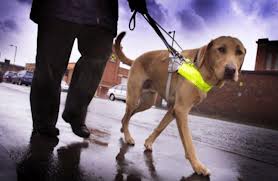The Disobedient Guide Dog
First you must learn to obey. Good.
Then, it is just as important to learn to disobey.
We teach children to obey their parents and all the other authority figures in their lives. This is critical, not just for their moral development, but for their basic safety and well being. When I was a young boy I remember being told, “Do not cross Pine street.” That was my limit. I could play anywhere on this side of that busy road in front of our home. Had I disobeyed that rule, I might very well not be writing this blog post today.
As we grow older, the authority figures continue to tell us who we are, what we believe, what is of ultimate value, what makes life “successful,” what makes a person happy. Later still, they will have distinct opinions on where we ought to go to school, and the kind of jobs or professions which are best for us, how we should raise our children.
The tricky thing is, the early influence of strong authorities is a gift and blessing—we all know children and young people who are adrift or deeply troubled because no one cared enough to insist on certain limits and boundaries, no one cared enough to shape their identity and direction. If you had parents and teachers and coaches and mentors who laid down some clear rules and demanded your obedience, count yourself blessed.
The tricky part is—at some point, a strong, healthy soul must also learn to say No to those authority figures.
I once heard a guide dog trainer speak about how these remarkable companions are trained to assist the blind.
You have to teach the dog to obey certain commands of course, but, the trainer said, it’s critical that this dog also know how to think for itself and disobey certain commands. If you’re standing at a street corner and you tell this dog to go, and the dog sees a bus bearing down on you, you want the dog to be able to say No.
To train it in this way, she said, they take the dog to, say, a railroad crossing. Just as the train comes along, they give the dog the ‘Go’ command, and when the dog balks, they praise her lavishly. The dog learns: “All right, when I’m commanded to do something that I think is not a good idea, I can say no, and that’s not just OK, I get praised.”
Coming into spiritual maturity as a man or woman always means learning to say No to the authorities. In this way, we begin to author our own lives. We receive the gift of our heritage, our tradition, but we know the moment when, to honor it, we must—paradoxically—set it aside. In a strange way, the tradition is what teaches us how to transcend it! Jesus shows us how to do this when he resists the call of his family to abandon his mission and come home (Matt. 12:46-50); when he denounces the “scribes,” the revered religious teachers (Matt. 23:13); when he cleanses the Temple (Mark 11:15-19).
Very often, it is not until later in life that we understand how, in many ways, we have always said Yes, even when we knew in our own hearts that it was time for No.
The beauty is, it is never too late.

I find that I am most centered when I have the courage to say no. If I don’t I am spewing energy all over the place leaving an empty tank for the most essential parts of my life – my family, my health, my friends, my God. Oh, and my dog Dixie!! Thanks David, going to keep it simple this afternoon. It’s a good place to start.
Good point, David. I know that I need some wisdom and some self-management so that this exercise is not just another form of self-delusion, an expression of the ego. Often, when I feel the impulse to defy it is just the point at which I most need to submit.
Oh yes, it is good to know how to say No,
and I love this illustration with the Guide Dog.
Thank you.